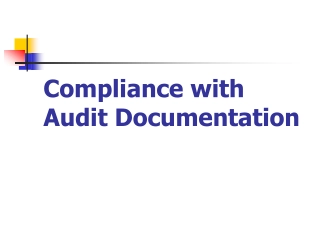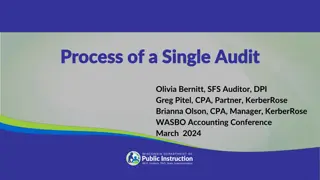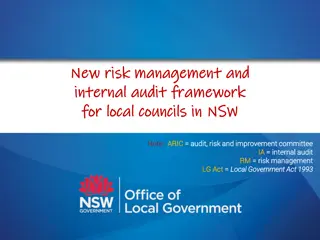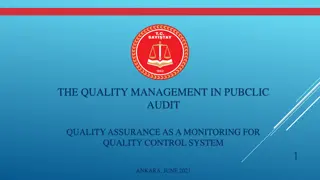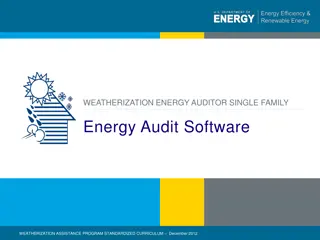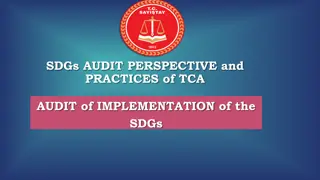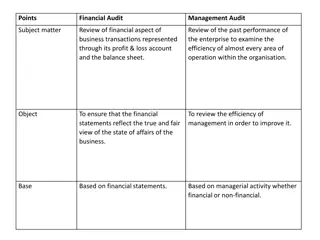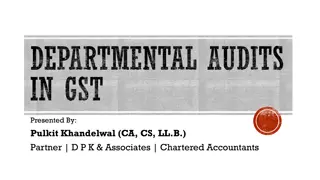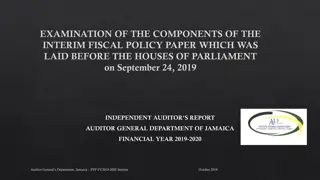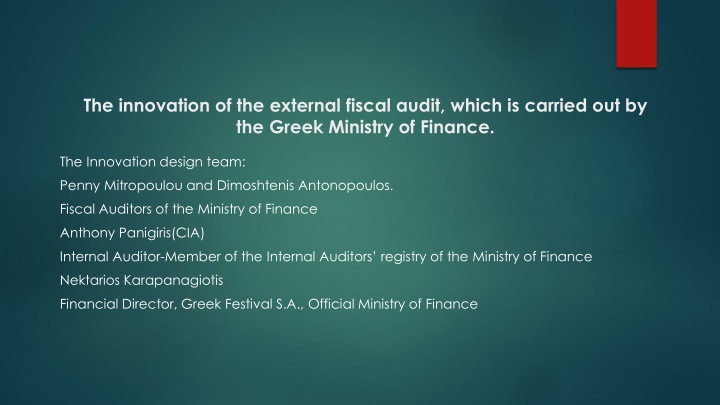
Innovative Fiscal Audit Practices by Greek Ministry of Finance
Discover the innovative external fiscal audit implemented by the Greek Ministry of Finance, highlighting the roles of the design team, auditors, and legal foundations. Explore the internal audit system, three lines of defense model, and continuous auditing procedure shaping effective management and control in the public sector.
Uploaded on | 0 Views
Download Presentation

Please find below an Image/Link to download the presentation.
The content on the website is provided AS IS for your information and personal use only. It may not be sold, licensed, or shared on other websites without obtaining consent from the author. If you encounter any issues during the download, it is possible that the publisher has removed the file from their server.
You are allowed to download the files provided on this website for personal or commercial use, subject to the condition that they are used lawfully. All files are the property of their respective owners.
The content on the website is provided AS IS for your information and personal use only. It may not be sold, licensed, or shared on other websites without obtaining consent from the author.
E N D
Presentation Transcript
The innovation of the external fiscal audit, which is carried out by the Greek Ministry of Finance. The Innovation design team: Penny Mitropoulou and Dimoshtenis Antonopoulos. Fiscal Auditors of the Ministry of Finance Anthony Panigiris(CIA) Internal Auditor-Member of the Internal Auditors registry of the Ministry of Finance Nektarios Karapanagiotis Financial Director, Greek Festival S.A., Official Ministry of Finance
The legal and scientific basis for this innovation is the following : The internal audit system in public sector. 1. The three lines of defense model effective management and control. 2. The Internal Audit 3. The Continuous Auditing procedure 4.
1. The internal audit system in public sector. According to Law 4795/2021, it is the set of actions, procedures, and auditing tools that an organization implements to provide reasonable assurance that its goals will be met. Regarding: effectiveness and efficiency of its operational functions. reliability of financial and other reports. Taking the International Audit Standards into account, it follows the laws, rules, and policies that govern how it works.
2. The three lines of defense model effective management and control. According to the Institute of Internal Auditors' revised "Three Lines Model" (2020), it helps agencies find structures and processes that help them achieve their goals and make good governance and risk management easier. The model applies to all entities and is optimized by: The use of a method based on principles that are unique to the organization's goals and needs Recognizing the role that risk management plays in helping the organization reach its goals helps build and keep goodwill. There is a clear understanding of the model's roles and responsibilities and how they connect to each other. They are taking steps to make sure that the activities and goals of the entity are in line with what is best for the public.
The three lines of defense in effective management and control
3. Internal Audit The independent, objective assurance and consulting activities are designed to add value and improve an organization's operations. It helps an entity achieve its goals by bringing a systematic, disciplined approach to evaluating and improving the effectiveness of risk management, control, and governance processes. It is based on the International Standards of Internal Auditing and the framework defined by the Committee of Sponsoring Organizations of the Treadway Commission (COSO).
4. The Continuous Auditing procedure The advantages of continuous audit, compared to the traditional one, have been highlighted in a number of scientific articles. They are summarized in the following table:
The Ministry of Finance as external auditor The external audit competence of the Ministry of Finance was legislated in 2006. Its mission is to ensure the fiscal management of the state and the direct or indirect state-financed entities. It has the authority to carry out regular fiscal performance audits. The potential number of audited entities amounts to several thousand. Currently, the audit capacity with the traditional method is up to 120 audits per year. Therefore, by the traditional method, a full cycle of budgetary control becomes impossible within a reasonable period of time. This issue is to be solved within just one year by the proposed innovation, as the financial auditor is freed from the time-consuming collection of primary audit data and focuses on the scientific field of their evaluation and their targeted further investigation, supported computerized application. by a constantly evolving
The innovation of automating fiscal audits The innovation consists of the development of an interactive online application for the fiscal evaluation of all public sector entities through the filling out by them of appropriately formatted thematic questionnaires and uploading the material documenting their answers. In more detail, the actions required are the following: Step 1: Action required by public entities: Fulfillment of audit questionnaires Step 2: Action required by the audit authority First evaluation: simple scorecard Step 3: Advance evaluation by the audit authority : Balanced Scorecard Step 4: Action required by public entities: Revaluation Step 5: Audit authority-mandated action: on-the-spot audits
Flow chart of continuous automated audit process Cluster sampling On-the-spot audits On-the-spot audit reports imposition of fiscal sanctions Digital audit reports Advanced reports Revaluation reports Questionnaire responses from the entity s administration Questionnaire responses from the entity s internal audit unit Processing Revaluation Data analysis Warnings management Trend analysis Risk analysis Risk mapping Comparative analysis Questionnaire responses from the entity s administration Questionnaire responses from the entity s internal audit unit On-the-spot audits decisions On-the-spot audits Inputs Outputs
Step 1: Action required by public entities: Fulfilling of audit questionnaires Discrete and uniquely certified electronic submission of administration and internal control unit responses to specially adapted fiscal control questionnaires. Uploading of the material documenting the answers The existing fiscal audit questionnaires have to be adjusted in order to reflect that they now only allow closed YES/NO responses with a field for submitting a document or papers as reason. The questions were also ranked in terms of priority so that the audited body's total financial performance score could be calculated.
Step 2: Action required by audit authority: First Evaluation of the Public Entities Electronic processing of the data collected from the public entities: control of discrepancies in management and internal audit unit responses. The audit risks that come from how each institution works differently based on its thematic or overall score Documents are automatically sent to the institution's management and internal control unit. These documents show what needs to be fixed and when the institution should be re-evaluated based on the financial risk it poses. Find the entities that need a financial audit on the spot, paying special attention to the ones with the most problems. Export the data to files editable by data analysis software.
First Evaluation: Simple Scorecard An example of the rating ranking of entities
Step 3: Advance evaluation: Balanced Scorecard Four Key Performance Indicators (KPI s) have been defined: Identity and operating framework of the body. The entity's organization, staffing, operation, and infrastructure Financial management - ensuring adherence to legislation and organizational obligations Compliance with publicity and information rules
The Balanced Scorecard model for the state-financed entities is as follows:
Step 4: Revaluation of the public entities The entities with the lowest evaluation (high risk) will be informed immediately to submit, within six months, material documenting the actions to improve their fiscal performance and their results. The entities with the higher evaluation (low risk) will be update the questionnaire every year
Step 5: On-the-spot audits On-the-spot audits On-the-spot audit reports Imposition of fiscal sanctions Cluster sampling will still be used to do on-site audits of public entities in the traditional way: The risk level of the entity as a whole or in certain areas of its work, with a 75% weighting factor. on the basis of random sampling, with a weighting factor of 25%.
The advantages of implementing the innovation It dramatically reduces the time required to complete a full public sector audit cycle. Efficiency, as with the continuous control of 100% of the entities, provides a high rate of assurance because more controls are carried out for the same cost. Focus on the lowest-rated and highest-risk entities. creation of a particularly important operational fiscal database for the agencies. immediate detection and correction of errors, which can have a significant financial cost. Instilling a culture of effective fiscal management in public entities through the continuous effort to improve their score. The continuous updating of the electronic questionnaire, based on the evolution of the legal framework, will function as a user manual of fiscal management for the entities. direct inclusion and utilization of the internal control procedure as an added valve for public entities. The possibility of integrating the proposed process into a Digital Governance Operational Program

